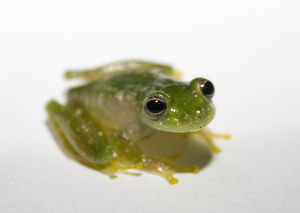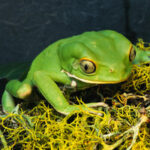When my daughter was a year and a half old, I found a green tree frog hopping through my house, much to the interest of my cats. I caught the little guy in my hands and– knowing he’d naturally become dormant in the winter– decided to keep him until spring time. For the next several months, I took excellent care of the critter my daughter named “Fug,” keeping him in a beautiful, moist habitat with lots of climbing spaces and an abundance of gut-loaded crickets to eat.
I’d read in every parenting book that reptiles weren’t safe pets for young children, and my daughter’s own pediatrician even reminded me at my daughter’s eighteen-month check-up that reptiles like turtles, iguanas and bearded lizards can carry Salmonella, a form of bacteria that can cause life-threatening diarrhea, especially in young children. Although I knew to be wary of reptiles, I had no idea that our glistening green tree frog– an amphibian, not a reptile– might also harbor the disease. I remained blissfully unaware that Fug might actually be a danger to my little one.
As it turns out, though, pet frogs and toads can harbor Salmonella, just like their scaly cousins. According to the CDC, pet amphibians like frogs and toads are frequently silent carriers of the potentially deadly bacterium. White’s tree frogs, green tree frogs, fire-belly toads, and African clawed frogs are among the most popular first pets for children, but most parents are unaware that these critters are likely to spread a deadly disease.
The CDC recommends not keeping pet frogs or toads at all if you have a child under the age of five, since kids in this age group are the most likely to contract Salmonella from a pet reptile or amphibian. You should also avoid keeping pet amphibians if anyone in your home has a compromised immune system. If you already have a pet amphibian, your best bet is to treat its habitat like a fish tank and make sure your child doesn’t handle the animal or any of the potentially contaminated items inside the tank.
We were lucky that, despite fairly frequent handling, Fug never got my daughter sick. In the three months he stayed in our home, we managed to dodge the bullet that we didn’t even know was there. And, once spring rolled around and it was time to release Fug back into the wild beyond, he hopped away cheerfully and and healthily as my toddler waved good-bye. Although our experience keeping a pet amphibian (at least for a little while) was rewarding, fun, and educational, I wish I had known that I was putting my child in danger by keeping Fug around. No amount of joy from a pet frog or toad could be worth the risk of serious illness in a child– so, if you have a kid under five years of age, stay away from pet frogs and toads.








